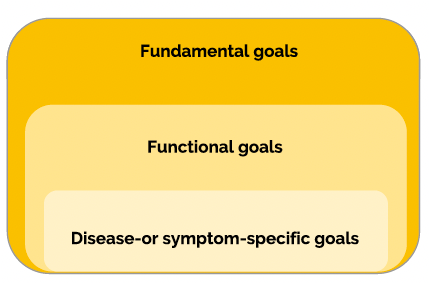Set Great Goals: Achieve Great Outcomes
Patient centered care is gaining momentum in the literature due to its positive impact on improving clinical outcomes, adherence and patient satisfaction. Characterised by considering the patient as a person, patient centred care utilises a biopsychosocial perspective, sharing power and responsibility and developing a strong therapeutic alliance1.
As outlined by Hutting et al1, the elements of a strong therapeutic alliance are:
- Collaborative goal setting, where patients identify goals based on their values and preferences
- Shared decision making
- Building a strong therapeutic relationship through empathy, giving hope and developing trust
Goals Have To Be Meaningful
We have all had an experience in our clinical practice where we have made inaccurate assumptions about a patient’s goals based on our own personal values, preferences and beliefs2. To establish a collaborative goal that is meaningful to our patient, we need a mutual understanding of what they would like to achieve. This has been shown to have positive influences on self-efficacy and quality of life in people living with long-term conditions2.
In Vermunt’s qualitative study, three levels of collaborative and interrelated goals are described. Ideally, we should be obtaining a goal from each level3.
Symptom specific goals are usually the first goal that a patient will articulate ie “to not leak urine”. Vermunt argues it is important to expand on this to include a functional goal ie “to be able to play tennis and not leak urine”. Vermunt also highlighted the importance of explicitly discussing fundamental goals with each patient, which take into account the values, hopes, relationships, emotions and priorities of the patient3 ie “to have the confidence to play tennis and not leak urine, so that I can enjoy socialising with my friends and stay active”. We can never assume these fundamental goals unless we discuss them with the patient overtly.
How Do We Set Goals?
We are all very familiar with the concept of a SMART goal (Specific, Measurable, Achievable, Realistic, Time Related). This acronym has been recently expanded to SMARTER, which also includes Evaluated and Reviewed. It makes sense to include these two further variables. How do we know if a patient has achieved their goals if we don’t evaluate them or adjust them when appropriate?
What are Pelvic Health Goals?
At Women’s & Men’s Health Physiotherapy (WMHP) we draw on a person’s symptoms, values, hopes and priorities to set SMARTER Pelvic Health Goals with all of our patients. We use a whole person approach, creating a safe place to listen and truly understand our patient’s story. We establish meaningful connections and facilitate a conversation that supports our patients to establish empowering pelvic health goals.
Asking our patients why they want to achieve their symptom improvement and what achieving this goal will give them helps them clarify their explicit fundamental goal.
Some examples of our patient’s pelvic health goals are:
- “To be confident having a kick of the footy with my kids without worrying about leakage”
- "To use tampons with my period so that I can go for a swim as this helps me stay fit and clear minded”
- “To have pleasurable sex with my partner because that is important in our relationship”
- “To be able to enjoy a coffee with my friends knowing that I’ll be able to make it to the toilet on time”
The majority of our patients are working towards achieving 2 or more Pelvic Health Goals, which are often a combination of short and long term goals.
Our 10 Year Dream
At WMHP we are embracing our 10 year dream that by 31st May 2032, WMHP patients will have achieved 50,000 Pelvic Health Goals. We will do this by living true to our core purpose, Women’s & Men’s Health Physiotherapy exists to restore pelvic health, empowering every person to live their best life.
References
1. Hutting N, Caneiro JP, Ong’wen OM, Miciak M and Roberts L. Patient-centered care in musculoskeletal practice: Key elements to support clinicians to focus on the person. Musculoskelet Sci Pract. 2022: Feb;57:102434. doi: 10.1016/j.msksp.2021.102434.
2. Dukhu S, Purcell C and Bulley C. Person-centred care in the physiotherapeutic management of long-term conditions: a critical review of components, barriers and facilitators. International Practice Development Journal, 2018: 8(2)[2]
https://doi.org/10.19043/ipdj.82.002 3. Vermunt NP, Harmsen M, Elwyn G, Westert GP, Burgers JS, Rikkert MGO et al. A three-goal model for patients with multimorbidity: A qualitative approach. Health Expectations. 2018;21:528–538.
4. Søndenå P, Dalusio-King G, Hebron C. Conceptualisation of the therapeutic alliance in physiotherapy: is it adequate? Musculoskelet Sci Pract. 2020: 46;102131.doi: 10.1016/j.msksp.2020.102131.
October 2022






